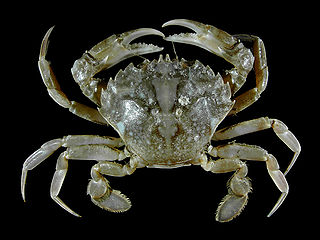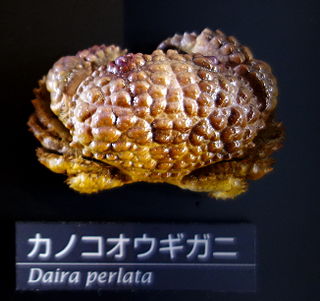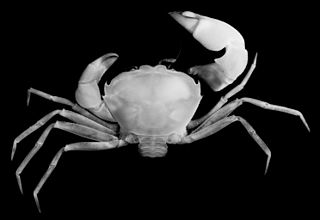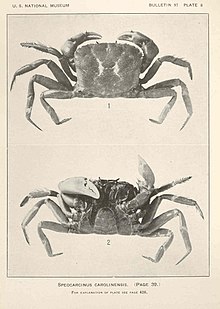
Cancridae is a family of crabs. It comprises six extant genera, and ten exclusively fossil genera, in two subfamilies:

Justitia is a genus of spiny lobsters. Following the recognition of Nupalirus as a separate genus, Justitia comprises one extant species and two fossil species:
Etyiidae is a prehistoric family of dromiacean crabs only known from Cretaceous and a few Paleocene fossils.

The Aethridae are a family of crabs in their own superfamily, Aethroidea. It contains these genera :

Hexapodidae is a family of crabs, the only family in the superfamily Hexapodoidea. It has traditionally been treated as a subfamily of the family Goneplacidae, and was originally described as a subfamily of Pinnotheridae. Its members can be distinguished from all other true crabs by the reduction of the thorax, such that only seven sternites are exposed, and only four pairs of pereiopods are present. Not counting the enlarged pair of claws, this leaves only six walking legs, from which the type genus Hexapus, and therefore the whole family, takes its name. Some anomuran "crabs", such as porcelain crabs and king crabs also have only four visible pairs of legs. With the exception of Stevea williamsi, from Mexico, all the extant members are found either in the Indo-Pacific oceans, or around the coast of Africa.

Eubrachyura is a group of decapod crustaceans comprising the more derived crabs. It is divided into two subsections, based on the position of the genital openings in the two sexes. In the Heterotremata, the openings are on the legs in the males, but on the sternum in females, while in the Thoracotremata, the openings are on the sternum in both sexes. This contrasts with the situation in other decapods, in which the genital openings are always on the legs. Heterotremata is the larger of the two groups, containing the species-rich superfamilies Xanthoidea and Pilumnoidea and all the freshwater crabs. The eubrachyura is well known for actively and constantly building its own burrows. The fossil record of the Eubrachyura extends back to the Cretaceous; the supposed Bathonian representative of the group, Hebertides jurassica, ultimately turned out to be Cenozoic in age.

Metacarcinus is a genus of crabs formerly included in the genus Cancer. It includes nine exclusively fossil species and five extant species, of which four are also known from the fossil record. A molecular study using the cytochrome oxidase I gene does not support the monophyly of this genus.

Corystidae is a family of crabs, in its own superfamily, Corystoidea. It includes what was once thought to be the oldest Eubrachyuran fossil, Hebertides jurassica, thought to be dating from the Bathonian ; the species was subsequently reinterpreted as being Cenozoic in age. Corystidae contains ten extant and five extinct species in eight genera:

Matutidae is a family of crabs, sometimes called moon crabs, adapted for swimming or digging. They differ from the swimming crabs of the family Portunidae in that all five pairs of legs are flattened, rather than just the last pair, as in Portunidae. Crabs in the Matutidae are aggressive predators.

Scyllarides is a genus of slipper lobsters.

Dairoidea is a superfamily of crabs, comprising two families which each contain a single genus: Dairidae and Dacryopilumnidae (Dacryopilumnus) .

Pseudozioidea is a superfamily of crabs, formerly treated in the Eriphioidea, Carpilioidea, Xanthoidea, Pilumnoidea and Goneplacoidea. A number of fossils from the Eocene onwards are known from the family Pseudoziidae. Eleven genera are recognised in three families:

Palicoidea is a superfamily of crabs, comprising the two families Crossotonotidae and Palicidae. Together, they contain 13 genera, including two genera in the Palicidae known only from fossils. The two families were previously treated as two subfamilies in a Palicidae of wider circumscription.

Planes is a genus of crabs in the family Grapsidae that currently comprises three extant species: Planes minutus, Planes marinus Rathbun, 1914, and Planes major (=cyaneus). A further fossil species is known from the Middle Miocene of the Caucasus.

Goneplax is a genus of crabs, containing the following extant species:
This list of fossil arthropods described in 2012 is a list of new taxa of trilobites, fossil insects, crustaceans, arachnids and other fossil arthropods of every kind that have been described during the year 2012. The list only includes taxa at the level of genus or species.
This list of fossil arthropods described in 2013 is a list of new taxa of trilobites, fossil insects, crustaceans, arachnids and other fossil arthropods of every kind that have been described during the year 2013. The list only includes taxa at the level of genus or species.
This list of fossil arthropods described in 2016 is a list of new taxa of trilobites, fossil insects, crustaceans, arachnids and other fossil arthropods of every kind that have been described during the year 2016, as well as other significant discoveries and events related to arthropod paleontology that occurred in the year 2016.
Acanthogalathea is an extinct genus of squat lobsters in the family Galatheidae. It was extant during the Eocene and Oligocene. It contains six species:

Xylopaguridae are a family of hermit crabs of the order Decapoda. It was erected in 2016 to accommodate one new genus, Prexylopagurus, and three existing genera that had previously been placed in Paguridae. They occur in the Atlantic, Indian, and Pacific Oceans.















